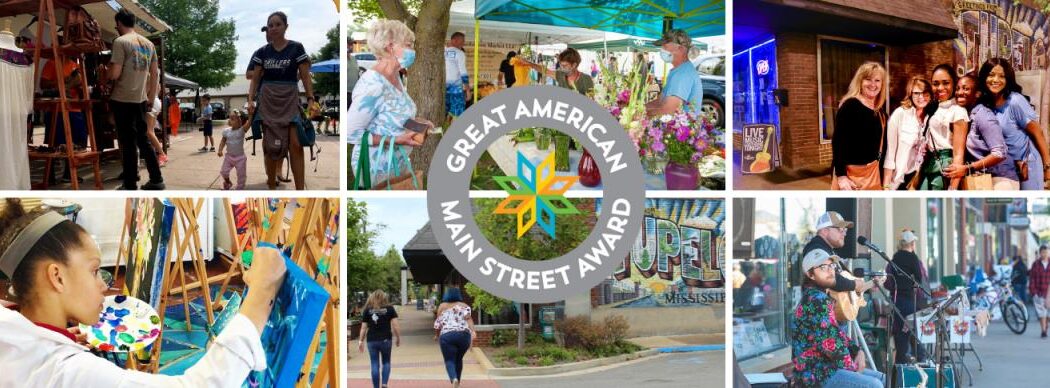On October 30, 2020, the National Main Street Center announced the three winners of its 2020 Great American Main Street Award (GAMSA): Boyne City Main Street in Boyne City Michigan; Downtown Tupelo Main Street Association in Tupelo, Mississippi; and Kendall Whittier Main Street in Tulsa, Oklahoma.
GAMSA is the nation’s top award for communities that have excelled in comprehensive preservation-based downtown revitalization. The winners were announced at the National Trust for Historic Preservation’s virtual PastForward Conference.
“This year’s GAMSA winners demonstrate the power of our commercial district revitalization approach to transform communities and turn around local economies,” said National Main Street Center (NMSC) President and CEO Patrice Frey.
“While these winning programs hail from small towns and larger cities, they have all brought vibrancy to their downtowns through inclusive community engagement, dedicated small business support, and innovative partnerships. I know their stories will serve as an inspiration to Main Streets across the country as they work to respond to the impacts of the pandemic,” she added.
Boyne City Main Street: Boyne City, Michigan
Located along Lake Charlevoix and the Boyne River in northern Michigan, Boyne City has harnessed its picturesque waterfront location to become a hub for year-round outdoor recreation.
The Main Street program has both enhanced access to natural resources and improved the sense of place downtown, thanks to a streetscape redevelopment project, developing a boardwalk and marina, adding public art, and implementing a façade grant program.
A strong roster of events, from outdoor music to food festivals, along with a dedicated volunteer base, has also brought vitality back to downtown.
The Boyne City Main Street program has been a catalyst for economic development. Since the Main Street program got its start, the downtown has seen 91 net new businesses and has a vacancy rate of just 1 percent, down from 5 percent in 2003.
Throughout the pandemic, Boyne City Main Street has ramped up their small business support, with a focus on connecting business owners to funding opportunities, helping them get online, and connecting merchants with resources to safely reopen.
The Main Street program has also deeply invested in its residents. As its downtown grew, Boyne City Main Street has worked with public and private partners to expand workforce housing.
Downtown Tupelo Main Street Association: Tupelo, Mississippi
Downtown Tupelo, Mississippi has built on its legacy as the home of Elvis Presley and transformed its Main Street from a buttoned-up corridor that shut down after 5 p.m. to a bustling district with live music, art galleries, and farm-to-table restaurants thriving alongside legacy businesses.
When the Downtown Tupelo Main Street Association (DTMSA) got its start in 1990, the downtown’s vacancy rate was 13 percent. Thanks to DTMSA’s supportive entrepreneurship environment, vacancy is just four percent today. DTMSA has continued to offer support to small business owners during the pandemic.
The program launched a dedicated website to support local merchants and provide one-on-one assistance with services like e-commerce support, social media training, and web development.
DTMSA has leveraged public and private partnerships to drive investment and development downtown, including converting a vacant former fairgrounds site into a vibrant mixed-use district that doubled the size of downtown.
Fairpark is now home to a visitor center, arena, museum, restaurants, convention center, and hotel. DTMSA continued to change the face of downtown by connecting Fairpark with the original downtown core and the Elvis Presley Birthplace through a major streetscape project.
DTMSA has spearheaded a range of inclusive community events that has made Tupelo the center of community activity.
Kendall Whittier Main Street: Tulsa, Oklahoma
In just 10 years, Tulsa, Oklahoma’s Kendall Whittier District has transformed from an area of decades-long blight into a thriving neighborhood with a mix of galleries, breweries, restaurants, and non-mainstream retail.
When Kendall Whittier Main Street (KWMS) got its start in 2010, the area had a 35 percent occupancy rate and was known as Tulsa’s red-light district– home to vacant storefronts and adult-oriented businesses. Thanks to community-led business recruitment and retention efforts, occupancy has grown to 100 percent today.
In all, KWMS has seen a total of 350 jobs created and $158 million private dollars reinvested. Even after COVID-19 forced many businesses to temporarily shut their doors, no businesses in the district have permanently shuttered due to the pandemic. KWMS credits a Rent Relief Program with making all the difference.
With people-centered transportation projects, affordable housing initiatives, and more than 20 annual events that reflect the diversity of the community, Kendall Whittier has seen progress without marginalization.
From art walks and outdoor concerts to yoga and food truck festivals, KWMS aims to offer free or low-cost programming that appeals to everyone in the community. Kendall Whittier’s revitalization has been so successful that it has become a model for other Tulsa neighborhoods and sparked a citywide Main Street program.
Image courtesy of National Main Street Center.

